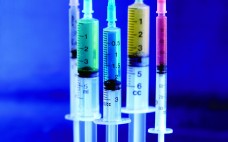Lonza, a global leader in the field of viral and cell therapy manufacturing, announced today the planned expansion of its industry-leading viral gene therapy business. Lonza plans to construct a new 100,000 square foot facility for viral and immunotherapy development and manufacturing in the Houston, TX (USA) area, complete with a fully segregated fill/finish suite. This new facility will more than double Lonza’s capacity for the production of viral gene and virally modified therapeutics. The state-of-the-art multi-purpose facility is expected…
Tuesday, June 16, 2015 Daily Archives
Additions to the MAS-100® Product Line of Microbial Air Samplers Deliver Improved Functionality for Pharmaceutical Manufacturers
EMD Millipore, the Life Science business of Merck KGaA of Darmstadt, Germany, today announced three additions to its MAS-100® product family. The MAS-100 Iso MH® and MAS-100 Iso NT® systems were developed for use in isolators and enable sampling at critical control points. The distinguishing feature of the MAS-100 Iso MH® system is its four sampling heads, which allow for increased monitoring capacity compared to single-head systems. The compact and easy-to-handle design of the MAS-100 VF® air sampler makes it well-suited for use in controlled environments. The…
From the Editor
More often than we realize, industry literature suffers from discrepancies in definitions of (seemingly) common, basic terms. We have pointed this out before — twice addressing the differences between analytical and bioanalytical testing, for example, and cautioning against misunderstanding the distinctions. Some terms are interchangeable, though, or it may be too soon to separate them from one another (e.g., cell therapies and therapeutic vaccines). We editors accept much of this as normal. Differences in interpretation will persist, and often a…
Spotlight
BioProcess Development Week 2015 by Maribel Rios From 30 March to 2 April 2015, more than 750 professionals gathered at the Hyatt Regency Resort in Huntington Beach, CA, to attend the annual Biopharmaceutical Development and Production meeting. Organized by IBC Life Sciences, BDP Week provided attendees with keynote addresses and sessions on the state of the bioprocessing industry and hot technical topics as well as preconference workshops, exhibit hall networking opportunities, poster presentations, and keynote addresses from five bioindustry leaders.…
Are You Ready for a Tech Transfer? Part 2: Overcoming Obstacles and Implementing Best Practices for Cell Therapy Technology Transfer
In part 1 of this two-part series, we outlined common challenges of technology transfer that are unique to the cell therapy industry and discussed strategies for success (1). Here, we delve even further into best practices and highlight key strategies for technology transfer that should be considered along the path to success. Creating a strong foundation for technology transfer will streamline clinical manufacturing processes and help position therapeutic products for long-term success. Below are key criteria for success. Confirm Transfer…
Challenges in Implementing Quality By Design: An Industry Perspective
In the fall of 2004, the US Food and Drug Administration (FDA) published a final report entitled Pharmaceutical CGMPs for the 21st Century: A Risk-Based Approach (1). This publication set the groundwork for a prospective risk‑based approach to pharmaceutical product development. It was published on the heels of a November 2003 agreement between the FDA and the International Conference on Harmonisation of Technical Requirements for Registration of Pharmaceuticals for Human Use (ICH) to develop an internationally harmonized plan for developing…
Special Report: A World of Difference — Biosimilars and Biobetters Offer Unique Benefits — and Risks
by John Otrompke, with Cheryl Scott and S. Anne Montgomery When the United States Food and Drug Administration (FDA) approved the country’s first ever biosimilar on 6 March 2015, it had been a long time coming. After all, the European Union had approved the first biosimilar in 2006, and a number of others have followed in Europe since then. Still, the approval of biosimilar filgrastim, a recombinant colony-stimulating factor used to offset the complications of chemotherapy, was a welcome step…
Assessing Similarity with Parallel-Line and Parallel-Curve Models: Implementing the USP Development/Validation Approach to a Relative Potency Assay
Potency is a critical quality attribute to support development and release of biopharmaceutical products. Researchers assess most protein-drug potencies using biological assays (such as cell-based assays), which mimic a product’s known mechanism of action or binding assays (if the only known mechanism of action is a drug binding to its target or if a drug is in early phases development). Potency denotes an important feature of complex biologics: their biological activity produced as a direct result of the molecule’s tertiary/quaternary…
Optimization and Scale-Up of HCIC-Based MAb Purification Processes, Part 2
In multistep schemes, hydrophobic charge-induction chromatography (HCIC) has been shown to contribute effectively to clearance of Chinese hamster ovary (CHO) host-cell proteins (CHOPs), DNA, and viruses. When used for capture chromatography, HCIC can provide better aggregate clearance than protein A sorbents can. Chen et al. enhanced clearance of aggregates, CHOPs, and product- related impurities by controlling HCIC based on both pH and the presence of binding-promoting salt in the wash and elution buffers used (1). Taken together with our findings…
Evaluation of a Variable-Pathlength Spectrophotometer: A Comparable Instrument for Determining Protein Concentration
Protein concentrations in bioprocessing are determined by multiplying the measured absorbance of UV light as it passes through a sample by the protein extinction coefficient. Conventional spectrophotometer measurements are based on a fixed pathlength depending on the cuvette used to hold the sample (typically 10 mm). Only a small portion of the UV curve is linear at that pathlength. As a result, conventional spectrophotometers have a limited linear range and are unable to measure a large range of protein concentrations…






